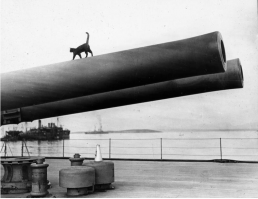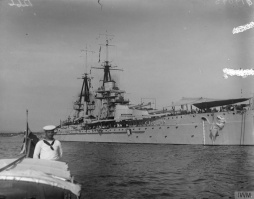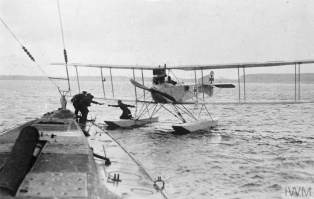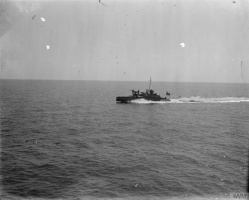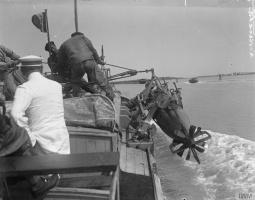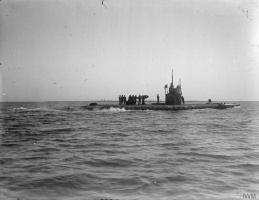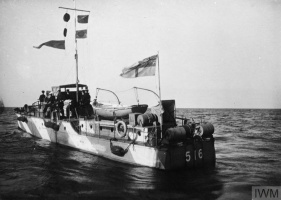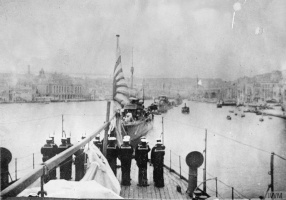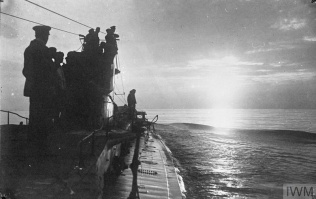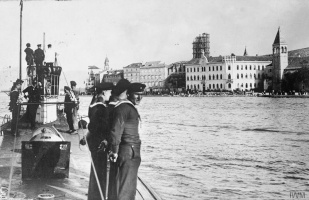Opening Moves↑
Major naval battles were anticipated in the Mediterranean both at the beginning of the war and in the final months of the war. They did not occur. In July 1914 the combined fleets of the Triple Alliance of Germany, Austria-Hungary, and Italy were strong enough to pose a serious challenge to the French and British naval forces in the Mediterranean. This was because the major British naval forces had been concentrated in the North Sea against Germany while Austria-Hungary in the decade before the war had put powerful warships in service. At the time, the Austrians had been building against the Italians but the two were allies in the Triple Alliance and a secret naval treaty calling for the union of their two fleets existed. In addition, the Austrians and Italians were to be joined by whatever German warships were in the Mediterranean. In 1914 these were the Mittelmeerdivision comprising the powerful new battlecruiser Goeben and fast light cruiser Breslau. How effective this Austrian-Italian-German force which had never maneuvered together would actually have been remains open to question. The issue was decided by the Italian declaration of neutrality on 2 August.
The commander of the Mittelmeerdivision, Rear Admiral Wilhelm Souchon (1864-1946), initiated hostilities in the Mediterranean on 3 August by bombarding Philippeville and Bône in Algeria. His intention was to disrupt as much as possible the repatriation of French troops from North Africa. Souchon decided against being cooped up in the Adriatic with the Austrians, whose fleet had proceeded well south to meet him, and headed for the Dardanelles. Thanks to a number of factors including the French preoccupation with covering the transit of troops in the western Mediterranean, the delay in commencement of Anglo-German hostilities and ambiguous orders from the Admiralty on the British side, the German ships escaped and in a fictitious sale were taken into Turkish service. The presence of the German ships was an important factor in the Ottoman decision to subsequently enter the war on the side of the Central Powers. However, their activity would be confined to operations against the Russians in the Black Sea and they would not reappear in the Mediterranean until 20 January 1918 when they sortied from the Dardanelles and sank a large and a small British monitor. Both ultimately ran into minefields: Breslau was sunk and Goeben damaged and saved only with difficulty after running aground.
For the first few months of the war the British and French enjoyed unimpeded use of the sea. The Austrian fleet was now hopelessly outnumbered and confined to the Adriatic. Its commander, Admiral Anton Haus (1851-1917) had to anticipate his former ally Italy becoming an enemy and he wisely rejected the logistically difficult if not impossible proposals to move the fleet to Constantinople. The French fleet assumed the major role in blocking the entrance to the Adriatic but the narrow waters and small Austrian submarine force soon made it too dangerous to risk large warships deep in the Adriatic. The entry of Italy into the war on the side of the Entente in May 1915 did not alter this situation.
The Arrival of German Submarines↑
The Anglo-French attempt to force the Dardanelles with warships failed on 18 March 1915 and was followed by equally unsuccessful attempts to break through with troops on the Gallipoli peninsula. The last British forces were evacuated in January 1916. The Dardanelles operations had a major result for the war at sea: they brought German submarines to the Mediterranean. The Turks had initially asked for Austrian naval assistance but the Austrians lacked the means; their submarines were too few and lacking in range. The Germans stepped in. At first small submarines were disassembled and shipped by rail to the Austrian naval base at Pola where they were re-assembled. The Germans, however, soon discovered that larger and more capable submarines could make the journey directly from the North Sea, passing undetected through the Gibraltar Straits. Their presence greatly complicated the Anglo-French naval operations at the Dardanelles.
The Germans realized that the Mediterranean was an excellent theater for submarine operations against merchant shipping. The weather was generally far easier to operate in than the North Sea, there were certain choke points where shipping routes converged, and at first little unity among the Allies in countering the threat. The Mediterranean had another advantage: American ships were less likely to be encountered here, sparing the Germans the diplomatic repercussions. The Germans increased the number of submarines operating in the Mediterranean until there were two flotillas operating from the Austrian bases of Pola and Cattaro at the beginning of 1918.
In March 1916 a conference at Malta divided the Mediterranean into national zones of responsibility as the Allies tried various unsuccessful methods to counter the submarines. These included dispersed routes for merchant ships or specified routes that were frequently patrolled. Moreover, British trawlers and drifters attempted unsuccessfully to block the Otranto Strait with a mine net barrage. Over the course of 1916, the heavy losses forced the British to divert an increasing proportion of traffic for India and the Far East from the Mediterranean and Suez Canal to the longer route via the Cape of Good Hope.
The German decision to introduce unrestricted submarine warfare in 1917 resulted in even greater losses and was only countered when the Allies began concentrating merchant ships in convoys. The convoy system eventually spread to the Mediterranean and losses were slowly brought under control, although never eliminated. The number of small craft available for escort work was a major problem and facilitated greater involvement of Allied powers other than France and Britain. A flotilla of Japanese destroyers arrived in April 1917 to operate with the British while in June 1918 American 110-foot wood craft named "Submarine Chasers" began patrols in the Strait of Otranto with hydrophones in an attempt to locate submarines by sound. The results were disappointing.
The Specter of the Russian Black Sea Fleet↑
No sooner had the submarine threat been brought under control when a new threat appeared. The collapse of Russia meant that in 1918 the Germans obtained control of a portion of the former Russian Black Sea Fleet. The Allies feared that some of these ships, which included powerful dreadnoughts, might overwhelm the obsolescent forces watching the Dardanelles and raid the Allied lines of communication to their forces in Salonika or Egypt and Palestine. There were on paper sufficient Allied heavy forces to meet the threat but the Italians insisted on command in the Adriatic and the French with their larger force refused. Consequently, two separate fleets, the French at Corfu, and the Italians at Taranto, were engaged in watching the smaller Austrian fleet. Ultimately the threat of the ex-Russian ships proved to be a mirage. Due to technical difficulties and a shortage of personnel the Germans could make little use of them.
Paul G. Halpern, Florida State University
Section Editor: Abdul Rahim Abu-Husayn
Selected Bibliography
- Halpern, Paul G.: The naval war in the Mediterranean, 1914-1918, Abingdon; New York 2015: Routledge.
- Halpern, Paul G. (ed.): The Royal Navy in the Mediterranean, 1915-1918, Aldershot; Brookfield 1987: Navy Records Society.
- Laurens, Adolphe: Le commandement naval en Méditerranée, 1914-1918, Paris 1931: Payot.
- Lumby, E. W. R. (ed.): Policy and operations in the Mediterranean, 1912-14, London 1970: Navy Records Society.
- Thomazi, Auguste: La guerre navale dans la Méditerranée, Paris 1929: Payot.






